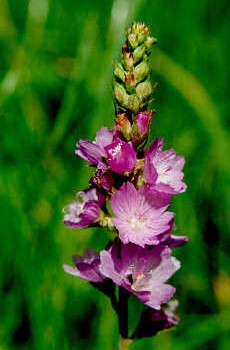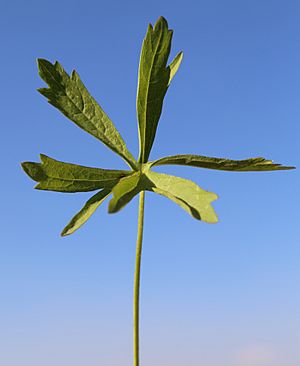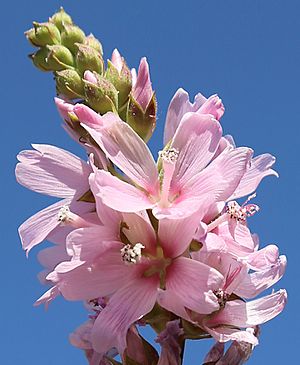Oregon checkerbloom facts for kids
Quick facts for kids Oregon checkerbloom |
|
|---|---|
 |
|
| Scientific classification | |
| Genus: |
Sidalcea
|
| Species: |
oregana
|
Sidalcea oregana is a beautiful flowering plant often called the Oregon checkerbloom. It belongs to the mallow family, which also includes plants like cotton and hibiscus. This plant is known for its pretty pink flowers.
Contents
Where It Grows
The Oregon checkerbloom naturally grows in western North America. You can find it from British Columbia in Canada, south through California, and east to Utah in the United States. It likes to grow in wet places. These include marshes and meadows.
This plant can look a bit different depending on where it grows. Because of these differences, scientists have divided the species into a few groups called subspecies. Some even recognize smaller groups called varieties. Generally, this plant is a perennial herb. This means it lives for more than two years. It grows from a strong, woody taproot and can reach over one meter (about 3 feet) tall.
What It Looks Like
Sidalcea oregana usually feels hairy. The hairs are thick and bristly near the bottom of its stem. Most of its leaves grow low on the stem. They are either at the base or on long stalks called petioles. The leaf blades are often deeply divided into several parts, like fingers on a hand. Leaves higher up on the plant might be divided even more.
The flowers grow in a cluster called an inflorescence. This cluster looks like a dense or open spike. Each flower has five pink petals. These petals can be up to 2 centimeters (about 0.8 inches) long. They usually have a small notch at the end. In the center of the flower is a tube made of its reproductive parts.
Different Types of Oregon Checkerbloom
Scientists have identified several subspecies of Sidalcea oregana. These are slightly different versions of the plant. Some of these subspecies are very rare and need special protection.
Here are some of the subspecies:
- Sidalcea oregana var. calva (Wenatchee Mountains checkermallow): This plant is endemic to the Wenatchee Mountains in Washington. This means it grows only in that specific area. It is a federally listed Endangered species. This means it is at high risk of disappearing forever.
- Sidalcea oregana ssp. eximia (coast checkerbloom): This subspecies is found in only about 10 small groups in northwestern California. It is a Critically endangered species. This is the highest risk category. It is listed on the California Native Plant Society Inventory of Rare and Endangered Plants.
- Sidalcea oregana ssp. hydrophila
- Sidalcea oregana ssp. oregana
- Sidalcea oregana ssp. spicata (spicate checkerbloom or bog mallow): This type is common in meadows and along streams in the Sierra and Cascades mountains in California. It grows below 10,000 feet (about 3,000 meters).
- Sidalcea oregana ssp. valida (Kenwood Marsh checkerbloom): This subspecies is known from only two marshes in Sonoma County, California. It is listed as an endangered species by federal, state, and CNPS groups.
Plant and Animal Connections
The Oregon checkerbloom is important for some insects. It acts as a larval host for the West Coast lady butterfly. This means the butterfly's caterpillars eat the plant's leaves. They use the plant for food and shelter as they grow.



